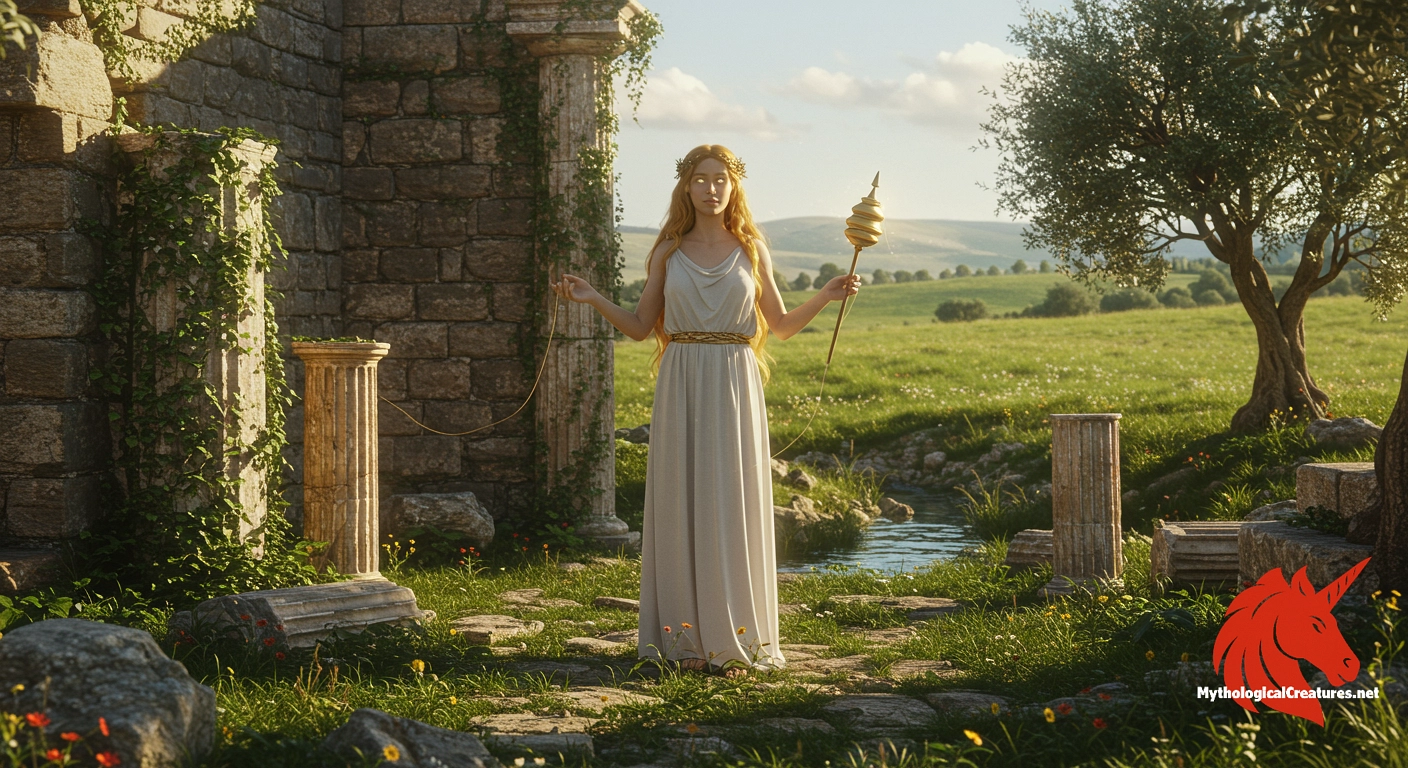Clotho: Clotho is the Greek goddess who spins the thread of human life, determining the destiny of both mortals and deities.

Clotho
Clotho - Central to the understanding of fate in Greek mythology, Clotho's divine intervention in the cycle of life and death has influenced countless interpretations of destiny throughout history.
Origins & First Encounters
Clotho emerges as the youngest of the trio of fates, intimately woven into the fabric of ancient Greek belief as the spinner of life’s thread. Her role surpasses the mere act of spinning, symbolising the creative force behind every mortal birth and the intricate design of destiny. Rooted in early mythological traditions, her influence reflects a deep cultural reverence for the delicate balance between life and death. The narratives surrounding her character depict a deity who not only initiates life but also holds the power to resurrect and transform fate. Embodied as a symbol of both creation and cessation, she represents the transient yet profound nature of existence. Her myth, interlaced with themes of renewal and destiny, highlights how the ancients perceived the unpredictable forces that govern human life. Clotho’s presence in mythology brought together the realms of divine intervention and human mortality in a seamless tapestry. Over time, her depiction has been enriched with layers of symbolism that continue to resonate with modern sensibilities. Her enduring legacy serves as a bridge between the mystical past and the complex understandings of fate in contemporary culture. The story of Clotho reminds us that every life is a thread in the vast, ever-unfolding fabric of existence.
Source Texts & Tale Variants
Ancient literary and artistic sources preserve the multifaceted narrative of Clotho in varied and compelling ways. Texts such as Hesiod’s Theogony offer some of the earliest glimpses into her role, portraying her as the divine spinner who weaves the destiny of mortals and gods alike. Additional fragments from epic cycles and mythographical treatises have enriched the tapestry of her legend with alternate details and nuances. These diverse sources sometimes present her as a benevolent force in the cosmic order, while other iterations evoke a more mysterious or even capricious figure. Ritual inscriptions and vase paintings provide further evidence of her revered status, capturing both her mythic role and symbolic essence. In certain stories, her miraculous interventions, such as the resurrection of Pelops, illuminate her profound command over life’s course. Some traditions even credit her, alongside her divine sisters and Hermes, with laying the foundations of cultural innovations such as the alphabet. The multiple layers of her narrative across sources attest to a dynamic, evolving mythos that both defined and was defined by the ancient worldview. These varied accounts, while sometimes conflicting, together contribute to a rich mosaic that continues to intrigue mythologists and enthusiasts. Each version adds depth and texture to the enduring story of Clotho and highlights the fluid nature of myth in the ancient world.
Form & Powers
Artistic renditions of Clotho frequently portray her as an ethereal figure with an ageless, serene beauty that belies her immense power. She is typically depicted dressed in graceful, flowing robes that evoke the timeless movement of the thread she spins. In these images, her delicate hands are often shown expertly manipulating a spindle, underscoring the precision and care with which she weaves fate. Her facial features, rendered with both softness and determination, reflect a calm authority that resonates with the gravity of her divine duty. Clotho’s eyes are sometimes depicted with a subtle luminescence, suggesting an inner wisdom that sees beyond the mortal realm. The intricate details of her attire and accessories, such as filigree ornaments and symbolic motifs, serve as visual allegories for the cyclical nature of life. Variations in her portrayal across different artworks often highlight her dual capacity for both nurturing creation and enforcing destiny. Some regional artistic traditions have enhanced her form with a radiant glow or otherworldly aura, emphasising her separation from mortal constraints. The careful balance between delicacy and power in her physical depiction speaks to the ancient understanding of fate as both fragile and immutable. Overall, these visual interpretations help to immortalise Clotho as a transcendent embodiment of life’s perpetual weave.
Regional Faces
The myth of Clotho exhibits intriguing regional nuances, with different local traditions adapting her narrative to reflect varied cultural attitudes toward fate. In mainland Greece, she is often portrayed within the triad of the Moirai, where her role as the spinner is interwoven with local rituals surrounding birth and death. In certain regions, such as parts of Asia Minor, her attributes merge with those of indigenous deities, thereby enhancing the enigmatic quality of her divine function. The Roman adaptation of her myth, where she is identified with the goddess Nona, presents her as part of a broader interpretation of fate and fortune. In areas like Attica, festivals and local iconography emphasised her role not merely as a fate-decider but as a nurturer of life’s beginnings. Diverse artistic representations found across various locales reflect a blend of influences, from more austere depictions in some sanctuaries to lavish and ornate portrayals in others. Such regional variations demonstrate how communities adopted and modified the myth to resonate with their specific cultural experiences and religious sensibilities. Local legends sometimes attribute additional miraculous interventions or creative roles to her, further enriching her narrative. The adaptability of her myth underscores the fluid boundaries of mythology in the ancient world, making her story a shared yet individually coloured tradition. Ultimately, these regional adaptations serve to illustrate the universal appeal of Clotho’s symbolism while underlining the diversity of its expression.
Cultural Parallels
Clotho’s role as the spinner of life’s thread finds striking parallels in the mythological traditions of many cultures. In Norse mythology, for instance, the Norns perform an almost identical function, weaving the fates of gods and men in a manner that mirrors Clotho’s sacred duty. This shared motif of spinning or weaving destiny highlights a recurring human fascination with the concepts of time and destiny. In Celtic lore, narratives of wise female figures who oversee the cycles of life bear a resemblance to the functions attributed to Clotho. Similarly, in various Eastern traditions, the imagery of threads and weaving is employed as a metaphor for the interconnectedness of life and the unfolding of destiny. These cross-cultural comparisons suggest that the idea of attributing destiny to a divine weaver is a near-universal archetype. The recurring presence of such figures in mythology points to a common understanding of fate as an intricate tapestry shaped by forces beyond human control. In many of these traditions, the act of weaving is symbolic of both creation and eventual dissolution, underscoring the dual aspects of nurturing and termination. This comparative analysis enriches our appreciation of Clotho’s role by demonstrating how different societies have used similar symbols to explore the mysteries of existence. Thus, Clotho stands not only as a cornerstone of Greek myth but also as part of a broader dialogue on destiny that spans global mythologies.
Legacy & Modern Evolution
The evolution of Clotho’s depiction attests to her enduring impact on both ancient and modern imaginations. Over time, her image transitioned from a strictly defined mythological role to an emblem of the inexorable weave of fate in literature and art. The Renaissance period rekindled interest in classical mythology, casting Clotho as a symbol of the eternal interplay between life and destiny. In modern narratives, her ancient role is often reinterpreted to examine contemporary issues such as free will, the passage of time, and the inevitability of change. Her myth has also permeated popular culture, inspiring a range of creative works from films and novels to digital and graphic arts. Modern reinterpretations sometimes imbue her with a more complex persona, highlighting internal struggles between creativity and destiny. The symbolic power of her spinning wheel and thread continues to serve as a metaphor for the delicate balance between control and chance. Academic discussions have also revisited her legacy, exploring how her ancient imagery can speak to present-day existential questions. As modern audiences seek to reclaim and revise classical themes, Clotho remains a potent icon of both continuity and transformation. In this way, the evolution of her myth mirrors the changing attitudes towards destiny and the perpetual human quest for understanding life’s intricate design.
Interesting Fact
An intriguing aspect of Clotho's myth is her act of resurrecting Pelops, highlighting not only her dominion over destiny but also her ability to transcend the natural order by manipulating life and death.
Quick Creature Info
Origin:
Associations:
Our Mythic Legendary Rating:

Also Sometimes Known As:
Habitat:
Supernatural Powers:
Physical Attributes:
Abilities:
Behavior:
Lore:
Related Creatures, Tales or Lore
- LLachesis
- AAtropos
- NNorns (Norse Fates)
References
Discover Another Mythical Legend You May Not Have Heard Of?
Uncover the mysteries of ancient folklore and expand your knowledge of legendary beings from cultures around the world.
Dare to Meet the Nang Tani....
Mythical Disclaimer: The images and data on this site are derived from various historical and literary sources, but we have found that many myths often have multiple versions and interpretations across references, sometimes contradictory. As a result, these creature depictions are artistic interpretations—imaginative blends of folklore, legend, and a dash of AI guesswork. Because creature descriptions vary widely, our illustrations and accompanying information represent our best effort to honor mythology while bridging creative gaps. Enjoy these interpretations—just remember, we've done our best to respect the stories and validate available data, but in the realm of mythology, details often shift, imagination leads the way, and nothing is ever set in stone!
Curated by the Mythological Creatures Team (rev. May 2025)
